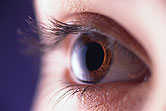- How Daily Prunes Can Influence Cholesterol and Inflammation
- When to Take B12 for Better Absorption and Energy
- Epsom Salts: Health Benefits and Uses
- See What Saffron Can Do for Sleep and Heart Health
- 6 Common Mistakes to Avoid Before Your Physical
- Can Sweating Really Help You Beat a Cold?
- Strengthening Your Relationship: Practical Strategies
- Skip Storing This Everyday Product in the Fridge Door
- Green Tea + B3 Pairing May Boost Brain Health
- Navigating Your Midlife Crisis: Embracing New Possibilities
Hispanic, Poor Children May Have Greater Risk of Losing Eye to Cancer


Hispanic and poor children with a rare eye cancer are at somewhat greater risk of losing an eye due to late diagnosis of the disease, a new study shows.
The finding suggests that these children have less access to primary care than white children and those from families with higher incomes, researchers said.
“Because retinoblastoma is most often diagnosed during well-child visits, the disparities uncovered in this study raise questions about inequities in primary care that go beyond the few children who develop this rare cancer,” said study senior author Dr. Carlos Rodriguez-Galindo. He is clinical director of the Solid Tumor Center at the Dana-Farber/Boston Children’s Cancer and Blood Disorders Center.
The study team looked at 830 cases of U.S. children under age 10 who were diagnosed with retinoblastoma — an eye tumor typically discovered during routine check-ups. The children were diagnosed between 2000 and 2010.
While nearly all of the children survived the eye cancer, Hispanic and poor children were somewhat more likely to lose an eye because their cancer was discovered at a later stage.
At diagnosis, the disease had spread beyond the eye in 33 percent of Hispanic children, and in 28 percent of children living in poor neighborhoods. Among non-Hispanic children and children living in better-off neighborhoods, that rate was just 20 percent, the researchers said.
Almost three-quarters of Hispanic children had to have the diseased eye removed, as did 74 percent of black and Asian children, the study found. Just under two-thirds of white children had to have their diseased eye removed, the study reported.
Slightly more than three-quarters of children living in poor areas had to have their diseased eye taken out. Meanwhile, 64 percent of those in wealthier neighborhoods needed to have the eye with the tumor removed, the researchers said.
“Despite the advances of recent decades in the care of children with cancer, disparities still exist. These disparities may impact children in different ways, depending on the type of cancer and treatment received,” Rodriguez-Galindo said said in a center news release
The study was published Oc.t 5 in the journal JAMA Pediatrics.
More information
The American Cancer Society has more about retinoblastoma.
Source: HealthDay
Copyright © 2026 HealthDay. All rights reserved.










